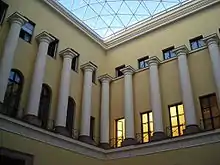

The Odeon is a former concert hall in the Odeonsplatz in Munich, Bavaria, Germany, which is named after it. Built in the early 19th century to a design by Leo von Klenze and forming a counterpoint to the externally identical Palais Leuchtenberg, it was rebuilt after being almost totally destroyed in World War II and now houses the Bavarian Ministry of the Interior.
History
The Odeon was built in 1826–1828 on a commission from King Ludwig I of Bavaria and was originally a concert hall and ballroom. Klenze designed the exterior as an identical counterpart to that of the Palais Leuchtenberg, so that there was no outward indication of its function.[1] The auditorium, which measured 75 by 125 feet (23 by 38 m) and seated 1,445, had two superimposed colonnades which provided access on the ground floor and a gallery with standing room, and a ceiling 50 feet (15 m) high with a skylight.[1][2] The orchestra was accommodated in a semi-circular exedra, behind which in niches were busts by Johannes Leeb of the ten composers then considered most important in the history of music: Beethoven, Mozart, Gluck, Handel, Haydn, Vogler, Méhul, Weber, Cimarosa and Winter.[2] The ceiling was decorated with frescoes in the Nazarene style: Apollo among the Muses by Wilhelm Kaulbach, Apollo among the Herdsmen by Adam Eberle and The Judgement of Midas by Hermann Anschütz.[2][3] The hall, which has been called "one of the most extraordinary classical architectural solutions of the concert hall",[4] had excellent acoustics and was popular with the public.[1]
The building was gutted in an air raid on the night of 25 April 1944. Beginning in 1951, it was rebuilt by Josef Wiedemann to house the Ministry of the Interior.[1] Recreation of the façade took until 1954. The former auditorium became an interior courtyard. Numerous lovers of music and architecture asked for it to be restored as a concert space, but this was not technically or financially feasible. The preservationist and architect Erwin Schleich campaigned for it to be recreated on the site of the Palais Leuchtenberg, also destroyed in the war, but despite widespread support organised by the Arbeitskreis Odeon (Odeon Working Group) formed by Schleich in 1960, that plan was also rejected. It pitted preservationists who argued that such a recreation would be a "forgery" against those like Schleich who valued "social utility" over authenticity.[5]
In 2003–06, the courtyard was covered with a glazed roof (a gridshell) by the architecture firm of Ackermann and Partner.[6]
References
- 1 2 3 4 Geschichte des Odeons: von Leo von Klenze bis heute Archived 2008-06-22 at the Wayback Machine, Bavarian Ministry of the Interior (in German), with historical photographs and plan.
- 1 2 3 Hermann Alexander von Berlepsch, Munich: Its Art-treasures and Curiosities; Supplement to Every Travelling Guide, Munich, 1871, OCLC 681426067, p. 45.
- ↑ J. Fey, "Der Maler Johann Adam Eberle", Aus Aachens Vorzeit 9 (1896) 119–28, p. 120 (in German) digitised at Archive.org.
- ↑ eine der außergewöhnlichsten klassizistischen Lösungen der Bauaufgabe Konzertsaal - Georg Dehio, Handbuch der Deutschen Kunstdenkmäler, Bayern Volume IV, München und Oberbayern, 3rd ed. rev. Ernst Götz et al., Munich: Deutscher Kunstverlag, 2006, ISBN 9783422031159, p. 878.
- ↑ Gavriel David Rosenfeld,Munich and Memory: Architecture, Monuments, and the Legacy of the Third Reich, Weimar and now 22, Berkeley: University of California, 2000, ISBN 9780520219106, pp. 189–92.
- ↑ "Hofüberdachung des ODEONs von Leo von Klenze, München: 2003 - 2006", Ackermann und Partner (in German), retrieved 3 March 2013.
Further reading
- Heinrich Habel. Das Odeon in München und die Frühzeit des öffentlichen Konzertsaalbaus. Neue Münchener Beiträge zur Kunstgeschichte 8. Berlin: de Gruyter, 1967. ISBN 9783110032772 (in German)
External links
- Heinrich Habel, Klenzes Odeon—zur Baugeschichte und Typologie, Bavarian Ministry of the Interior (pdf) (in German)
- Robert Münster, 117 Jahre klingendes Leben im Odeon, Bavarian Ministry of the Interior (pdf) (in German); originally published in Musik in Bayern 61 (2001) 53–64.
- Josef Wiedemann, Der Wiederaufbau des Odeons, 1950–51, Bavarian Ministry of the Interior (pdf) (in German)